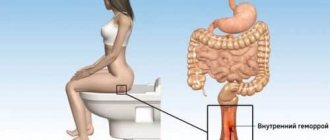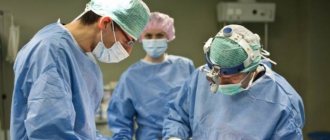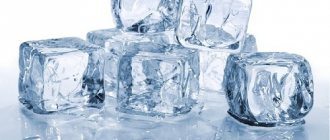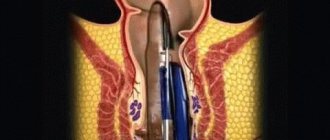Treatment in a hospital
Hemorrhoids are a chronic disease that worsens with an incorrectly selected diet, heavy lifting, childbirth and menstruation. The pathology occurs unexpectedly, since over a long period of time the inflammatory process can develop latently and asymptomatically. Itching, burning and heaviness in the anorectal area may alarm a person, but due to fear and embarrassment, he will not consult a doctor for a long time for diagnosis and treatment. Meanwhile, the disease has passed the first stage, at which you can even use homeopathic remedies to relieve unpleasant symptoms.
Gradually, the disease will progress, hemorrhoids will appear in new places and will increase in size. Their infringement will provoke bleeding, cracks and inflammation, which will be accompanied by infection. Perhaps at this stage, a patient with hemorrhoids will finally decide to visit a proctologist. But a specialist will have to look for potent drugs in order to treat hemorrhoids without surgery. The task is made a little easier by the fact that the pharmaceutical market is saturated with a wide range of products with proven effectiveness that successfully combat the manifestations of rectal pathology.
How does a hemorrhoid form?
Hemorrhoids are a disease that occurs due to varicose veins of the rectal venous plexus. It appears due to a genetic predisposition complicated by provoking factors.
The cavernous bodies of the rectum change:
- they increase in width;
- the number of vessels feeding them increases, which is why there is an increased blood flow;
- The connective tissue of the vein walls grows.
Hemorrhoids appear for two reasons:
- Increased blood flow to the veins located in the pelvic area. Their walls enlarge, change shape, and nodules appear.
- When hemorrhoids are advanced, the resulting bumps put pressure on the longitudinal muscle layer, which gradually weakens and ceases to hold the formations, which begin to fall out.
Treatment of hemorrhoids without surgery is possible in the early stages of the disease, as long as the pathological process is reversible.
Types and stages of hemorrhoids
Hemorrhoids have many manifestations. Only an experienced specialist will determine what form of the disease a particular patient has and will help treat hemorrhoids conservatively, without surgery. Thus, the disease can be inherent from birth or acquired.
Depending on the location, hemorrhoids can be:
- submucosal (internal);
- subcutaneous (external);
- combined.
Minimally invasive techniques (bloodless operations)
Coloproctologist
- minimal impact on the tissues adjacent to the inflamed hemorrhoids;
- short duration of the procedure (no more than half an hour);
- almost complete absence of pain when using local anesthesia (no anesthesia required);
- the patient does not need an inpatient rehabilitation period, returns home on the day of surgery, starts work the next day;
- minimally invasive techniques do not leave scars and do not deform the rectum or anus;
- the absence of serious contraindications suggests the use of a minimally invasive technique for removing hemorrhoids in older patients with many concomitant diseases;
- The low invasiveness of the techniques allows them to be used at any stage of hemorrhoidal disease.
Today, a number of such innovations are used:
- Desarterization is the most effective method of non-surgical removal of hemorrhoidal cones. The essence is ligation of the arteries supplying the cavity through an anoscope, after preliminary determining the location of each vessel using ultrasound. The result is the exclusion of hemorrhoids from the general nutritional system of the anorectal zone with their subsequent death. The procedure provides a 95% cure rate, guarantees no relapses, but is expensive due to the equipment used. Prices in Moscow: from 14,800 rubles to 91,700 rubles (depending on the number of knots to be tied, the qualifications of the surgeon, the status of the clinic);
- Latex ligation is the second most effective procedure: more than 90%. The essence is the exclusion of hemorrhoidal formation from the bloodstream after placing a latex ring on the leg of the node, which gradually contracts. After a couple of weeks, the internal hemorrhoid dies and is removed naturally along with the ring. Minus - only internal bumps are indicated. In addition, while the ring is being tightened, the patient may feel a foreign body in the anus. The cost of ligation in Moscow: from 2,400 rubles (for one node) to 18,000 rubles;
- Sclerotherapy is the elimination of hemorrhoids by injecting a special drug into the node, which glues the walls of the cone itself and the vessels that feed it. Blocking power leads to the death of hemorrhoids. The procedure is quick and painless. Minus - applicable only for internal hemorrhoids, excluded in case of individual intolerance to the sclerosant drug, recurrence is possible, since the cause of the disease is not eliminated. Prices for sclerotherapy in Moscow: from 1,500 rubles to 13,200 rubles, depending on the number of nodes removed;
- Laser coagulation is indicated for hemorrhoids of any location. The essence is the effect of the laser on the entire venous cavity, which causes coagulation of proteins in the walls of blood vessels and cones. The veins and arteries are soldered together, the nutrition of the caverns stops, the nodes disappear without bleeding within a couple of weeks. Cost of the procedure in Moscow: from 12,000 to 18,000 rubles (for 1 hemorrhoid);
- Infrared photocoagulation - exposure of the cavity pedicle to a beam of focused infrared light with coagulation of proteins in the walls of blood vessels, blocking normal nutrition. The procedure requires several sessions. It is used mainly in the first stage of hemorrhoidal disease. The procedure is comfortable and painless, but often causes relapses. Prices in Moscow: from 1,000 to 25,000 rubles.
- Cryodestruction is the freezing of hemorrhoids with liquid nitrogen (temperature below 180-200 C), which affects only the damaged areas, since healthy areas through the arteries create a thermal “border” that prevents the penetration of cold into nearby tissues. Dead cells leave the rectum in about a week. Cryodestruction is painless, leaves no scars, and does not cause bleeding. But it stimulates the immune system. Contraindications include thrombosis or necrosis of the node, progressive proctitis and paraproctitis. The procedure is not performed on pregnant and nursing mothers. In Moscow and large regional centers, the price for manipulation is 4,000 – 8,000 rubles. In the regions, the cost is slightly lower: from 3,000 to 6,000 rubles. Cryodestruction surgery is performed extremely rarely.
Therefore, before performing an operation to remove hemorrhoids, you should collect all the necessary information about the clinic and the surgeon to whom you trust your health, and read the reviews of operated patients.
Stages of development of hemorrhoids
| First stage | At this time, the disease does not yet manifest itself; sometimes itching or burning may bother you. The nodes that appear become engorged and sometimes bleed, as a result of which you can notice scarlet inclusions in the stool. Timely treatment allows the disease not to progress to the next stage of development and helps to completely get rid of unpleasant symptoms. |
| Second phase | The nodes begin to fall out, for example, after heavy physical activity. The cones can retract on their own. Drops of blood at this stage appear on the underwear. |
| Third stage | The disease is already considered advanced. The main symptoms in the form of pain, heaviness, burning and itching, bleeding cause suffering to a person, rearrange the usual course of business, interfere with work and leisure activities. Falling out knots at this stage can still be set back in by hand. |
| Fourth stage | The disease occurs in its most severe form and is chronic. The nodes can no longer be set back, they become pinched, bleed, become infected, and the inflammation becomes permanent. Treatment at this stage involves surgery. |
In the first two stages (stages) of the development of the disease, non-surgical methods for treating the symptoms of hemorrhoids are suitable, including the use of special local remedies, as well as taking systemic medications.
How does this insidious disease progress?
About 30% of the world's population suffers from hemorrhoids. Most patients are people leading a static or sedentary lifestyle: drivers, office workers. The disease often develops in athletes who expose themselves to great physical activity. Hemorrhoids also appear in overweight people, as well as in pregnant women. The disease occurs in four stages, each of which has its own symptoms.
The first stage is characterized by itching in the anus. A person begins to worry about constipation, and bloody discharge appears during bowel movements. Then a period of remission (rest) begins, and the sick person takes it for recovery, even if he has not been treated in any way. Over time, the picture changes. At the second stage, nodes begin to fall out of the anus, which can be adjusted independently. Constipation becomes more frequent, and spotting can be noticed not only during bowel movements.
Stage 3 hemorrhoids are characterized by frequent prolapse of nodes. It occurs during physical exertion, going to the toilet, and the patient can still straighten the nodes himself. But the fourth stage of the disease is the most severe. Hemorrhoids increase in size, become inflamed, fall out and interfere with walking. A person can no longer straighten them himself. In addition to pain and frequent bleeding, the victim is worried about anemia and thrombosis. Treatment of stage 4 hemorrhoids without surgery is impossible. Therefore, you should not prolong the disease, but go to a proctologist at the first signs.
Modern methods of treating hemorrhoids
The development of medicine, developments in the pharmaceutical industry, the emergence of modern diagnostic methods make it possible to combat hemorrhoids at different stages. But it’s better not to delay visiting a proctologist and start therapy when the first unpleasant symptoms appear. It is important not only to strictly follow all the doctor’s recommendations, but also to show persistence and patience, adjust your habits, and thus prevent the recurrence of the disease.
Treatment of hemorrhoids without surgery involves the use of systemic medications (“Phlebodia”, “Vazonit”, “Detralex”), local ointments (“Bezornil”, “Procto-Glivenol”, “Esculus”), rectal suppositories (“Anuzol”, “ Relief", "Proctosan").
An important point, the implementation of which in combination with other methods guarantees the success of treatment, is changing food habits. Instead of spicy and fried foods, you need to introduce vegetable and fruit smoothies into your diet, instead of soda and juices, drink more clean water, you need to give up alcohol and tobacco. It is also important to adjust your lifestyle - take time for jogging, gymnastics, and maintain a daily routine.
To get rid of irritability of the mucous membranes, you need to give up enemas, laxatives, and anal sex.
It is quite possible to cure hemorrhoids without minimally invasive surgery by exchanging heavy physical work for other types of work, using mild laxatives (Duphalac, Forlax) To correct bowel movements, adding additional hygiene procedures - baths with herbs, using wet wipes instead of paper .
Rehabilitation
The recovery period after removal of hemorrhoids proceeds differently for everyone, depending on the severity of the condition, symptoms, age, and concomitant pathology. The type of surgical intervention performed is of great importance. After an open hemorrhoidectomy, it takes a month and a half for rehabilitation, after a closed one – three weeks. Hemorrhoidopexy requires a week to return to work.
https://www.youtube.com/watch?v=bu7GH_c2VBM
During the rehabilitation period, it is important to follow the recommendations of the proctologist and be in constant contact with him. The doctor provides postoperative support to each patient after discharge from the hospital, until all problems that arose after the operation are resolved. The main directions of efforts during the recovery period look like this.
Removal of hemorrhoids involves limiting the load associated with increased intra-abdominal pressure - heavy lifting, active, sudden movements, straining during bowel movements. Instead, turning over from one side to the other, stretching, and breathing exercises are allowed. The goal is to prevent thrombosis, varicose veins, and in the first three days it is simply a distraction from postoperative sensations.
You can get up on the second or fourth day, depending on the patient’s well-being. As the wound heals, the number of exercises expands, but in a lying or standing state. Kegel exercises are effective for training the pelvic floor muscles.
You can sit down after the pain in the anorectal area disappears, no earlier than a week later. Slowly, gradually. Proctologists recommend a seat cushion or swimming ring to start with.
For the first two months, you cannot carry a load of more than 2 kg. The gym is allowed only after three months, with the exception of strength training.
Nutrition
A proper diet is the main condition for preventing the recurrence of hemorrhoids. According to patient reviews, surgery to remove hemorrhoids radically changes gastronomic preferences. On the first day after the operation, fast, so as not to damage the sutures by defecation. In the following days you need to follow simple rules:
- meals are fractional, in small portions, food is crushed to the maximum for complete but easy absorption;
- 80% of the diet is plant foods, boiled, baked or raw vegetables and fruits;
- meat and fish only lean;
- every morning – a teaspoon of vegetable oil and a glass of clean water before meals;
- the drinking ration is calculated according to the formula: 40-50 ml per 1 kg of weight (depending on the nature of the stool).
| Allowed | Forbidden |
| Buckwheat, millet porridge on water | Sorrel, cabbage, turnip |
| Low-fat kefir for the night | Raw apples, raspberries, dates |
| Skim cheese | Coffee |
| Baked vegetables, fruits | Smoked meats, pickles, marinades, canned food |
| Whole wheat bread | Legumes, mushrooms |
| Boiled chicken, beef | Baking, sweets |
| Vegetable soups | Fat meat |
| Herb tea | Whole milk |
Pain syndrome
Wound healing
Restoring the anorectal ring after surgery for hemorrhoids is one of the most important tasks of rehabilitation. A number of medications will help with this: Solcoseryl (gel, ointment), Levomekol, Natalsid, Methyluracil, Sea buckthorn oil. You can use traditional medicine recipes, especially sitz baths with decoctions of medicinal herbs.
Rehabilitation after removal of hemorrhoids includes daily intimate hygiene: after each bowel movement at home, washing the anorectal area and anus with cool water, outside the home - using wet sanitary napkins instead of toilet paper. Blot the treated surface with sterile wipes, not a towel. Linen should be without rough seams and made from natural fabrics.
Treatment of hemorrhoids without surgery
By taking a comprehensive approach to therapy, it is possible to cure hemorrhoids without surgery using conservative medicine methods. There are a huge number of examples in proctological practice. By supplementing the treatment regimen developed by the doctor with traditional methods, it is possible to achieve results in a shorter time. Thus, along with medicinal antihemorrhoidal suppositories, homemade suppositories are used, made in accordance with folk recipes.
Safe remedy for hemorrhoids
- Small candle-shaped pieces are planed from potatoes or cucumbers. When placed in the rectum, they are lubricated with fat or honey to avoid injury to the mucous membrane. The suppository will come out on its own during the first act of bowel movement after insertion.
- A suppository is formed from candied honey, frozen, and inserted cold into the anus.
- Mumiyo, butter and potato starch are mixed in equal parts, candles are formed, placed in the refrigerator, and used cold.
Also, according to folk recipes, decoctions are prepared for oral administration. They help treat hemorrhoids without surgery. An infusion made from carrot tops, taken several times during the day, will help relieve pain and reduce the intensity of the inflammatory process. Dry raspberry leaves, calendula, and sage have the same properties.
Decoctions are prepared from them, which are infused for several hours and taken before meals. Infusions made from hazel leaves, rose hips, and rowan will help cope with bleeding. Before taking homeopathic medicines, you should consult your doctor to exclude a possible individual hypersensitivity reaction or side effects.
Medications after surgery
Hemorrhoids require continuous treatment after surgery to speed up rehabilitation and prevent complications. Mandatory use of medications. For pain - painkillers, for constipation - laxatives, for bleeding - hemostatics. The basis, as before, is still venotonics.
- Detralex tablets. One of the best for preventing the recurrence of hemorrhoids during the rehabilitation period, the most popular. The drug is a representative of venotonics and consists of a complex of bioflavonoids based on diosmin and hesperidin. Detralex increases the tone of the veins, relieves congestion in the pelvic organs, and improves microcirculation in the anorectal area.
- Venarus tablets. Domestic analogue of Detralex. Synthetic venotonic with angioprotective properties.
- Phlebodia 600 capsules. A drug from the group of venotonics based on diosmin. After removal of deformed hemorrhoids, it tones the veins of the rectum, restores the vascular wall, relieves inflammation, blood stasis in the anorectal area, and balances microcirculation.
- Hemoroidin tablets. Venotonic dietary supplement with inulin, a natural prebiotic from chicory, which improves intestinal function. Contains flax leaves, dandelion, juniper fruits, dill seed, plantain leaves, ginkgo biloba, goosefoot roots - a total of 15 natural ingredients. There are no side effects at all. The main effect is analgesic, anti-inflammatory. Additionally, it normalizes stool.
- Proctonis tablets. Plant-based dietary supplement with hemostatic properties. The drug is often used to prevent bleeding. Contains: shark cartilage, yarrow, cilantro, licorice, senna. Proctonis increases blood clotting, regenerates rectal tissue, relieves inflammation, anal spasm, prevents secondary infection, and normalizes stool.
- Methyluracil tablets. A representative of the group of immunostimulants with angioprotective and photoprotective properties based on dioxomethyltetrahydropyrimidine. The drug has an anti-inflammatory effect, regenerates tissue, and is an angioprotector.
- Guttalax tablets. Mild laxative, acts in the large intestine, does not affect the digestion or absorption of essential nutrients in the small intestine. The active ingredient is picosulfate, which stimulates intestinal motility, accumulates fluid in the large intestine, which softens stool and stimulates bowel movements.
- Senade tablets. Senna is a drug that stimulates bowel movements by increasing peristalsis, dilutes fecal stones, prevents constipation, and is not addictive. A cheap but effective remedy for defecation disorders in the postoperative period.
- Nemesulid-tev capsules. Representative of non-steroidal anti-inflammatory drugs for oral administration. The main property is that it relieves inflammation and pain during the recovery period after surgery to remove hemorrhoids. In case of overdose, it can thin the blood, causing bleeding, so use with caution.
- Ibuklin tablets. A combined drug from the NSAID group based on ibuprofen and paracetamol with anti-inflammatory and analgesic properties. Suppresses the synthesis of prostaglandins, stops exudation, reduces the pastiness of rectal tissues after surgery, and has an antipyretic effect.
- Nise tablets. A drug from the NSAID group based on nimesulide is a monodrug with an anti-inflammatory and analgesic effect. Prostaglandin synthesis corrector. The active substance inhibits COX-2, suppresses inflammation, exudation, proliferation in the anorectal area, the drug has antipyretic properties.
- Solcoseryl ointment and gel. The drug is a regenerator. Accelerates the healing of damaged areas of the mucous membrane and skin by improving tissue metabolism, increasing collagen production, restoring the functioning of capillaries and veins.
- Levomekol ointment. Accelerates the regeneration of rectal tissues, disinfects the postoperative surface due to the combination of methyluracil and levomecithin. At the same time, liniment resists secondary infection.
- Ointment and suppositories Methyluracil. The drug belongs to the class of immunostimulating agents. Penetrating into tissues and cells, methyluracil accelerates metabolic processes, tissue regeneration and restoration, as well as the resistance of the epithelium to negative environmental influences. Additionally, the substance stops bleeding, reduces the intensity of inflammation and generally improves the condition of wound surfaces.
- Candles Sea buckthorn oil. The drug is an extract from sea buckthorn berries. A natural and effective remedy, heals the wound surface, disinfects the mucous membrane of the rectum and anorectal area. The oil component relieves inflammation, pastiness of the anus, and relieves pain.
- Natalsid candles. The drug is based on sodium alginate, which is a polysaccharide of seaweed. The main property is the healing of the wound surface in the rectum and anorectal area. At the same time, the medication exhibits anti-inflammatory properties and relieves pain.
- Relief suppositories and ointment. Preparations based on shark liver oil, phenylephrine, Oil - improves the condition of the epithelium of the anus, rectum, which stimulates regeneration. Phenylephrine constricts blood vessels, reduces swelling and inflammation. Relief Advance relieves pain due to the addition of the anesthetic benzocaine.
- Ointment Bezornil. A preparation based on pearls, amber, borneol, zinc, bezoar. The drug relieves inflammation, relieves pain, activates the immune system, and disinfects the wound surface. Pearls regenerate tissues and prevent blood clots. Amber is an antiseptic. Zinc – disinfects anorectal tissue.
- Hemorrhoids treatment drugs suppositories ointments
- Hemorrhoids symptoms and treatment at home
- Treatment of hemorrhoids with honey at home, reviews
- Hemorrhoids after childbirth: treatment during breastfeeding
Conservative methods
Doctor and patient
When symptoms of the disease appear, you need to take quick response measures to cure hemorrhoids without surgery. The doctor will recommend medications, the use of which will be effective in each specific case. So, ointments will help cope with external hemorrhoids, and rectal suppositories will help with internal hemorrhoids.
During treatment, it is necessary to carry out hygienic procedures that have a positive effect on the state of local immunity and relieve irritation. Cool baths with clean water or herbs should be done systematically before applying an ointment or introducing a suppository. When using special tablets in the treatment of hemorrhoids without surgery, it is important to follow the course developed by the proctologist, do not miss the time of administration and remember that anti-hemorrhoidal drugs work effectively in combination.
Sclerosis of affected areas
Sclerotherapy
If it is no longer possible to cure hemorrhoids without surgery, degenerative processes become irreversible, doctors perform minimally invasive surgical interventions. One of them is sclerotherapy. Special substances are injected into the hemorrhoidal cone, which cause blockage of the vessels supplying the node.
First it decreases, and then completely dries out and disappears. This operation is performed on an outpatient basis. It is contraindicated for cracks and wounds in the sphincter of the anus, pregnancy and lactation, thrombosis of nodes, and acute course of the disease. Such intervention is permissible in the early stages of hemorrhoids, when drug treatment does not bring tangible results. At the third and fourth stages of disease progression, the procedure is performed before surgery.
About minimally invasive therapy
It happens that the disease cannot be managed with conservative therapy alone. Then minimally invasive therapy comes into the fight - modern treatment for hemorrhoids, successfully used in many countries around the world. Minimally invasive methods are based on procedures that doctors perform in an outpatient setting. These are mini-operations performed without anesthesia, and they last only a few minutes. These methods include:
- sclerosis;
- doping with latex rings;
- infrared photocoagulation;
- disarterization.
All these new methods of combating hemorrhoids give the best effect at stages 1-2 of the disease, but can also be used at the third stage. What are they?
Sclerotherapy is a treatment for hemorrhoids without surgery. During this procedure, the doctor punctures the resulting inflamed node with a thin needle and injects a substance inside that causes scarring and subsequent death of the hemorrhoid. Sclerosis with 2-4 painless injections cures the patient. The disadvantage of this method is that in some cases, internal hemorrhoids may occur in a person after some time in another place. If the walls of the venous vessels are thin and weak by nature, then blood clots can form on them again. To prevent the recurrence of a delicate disease, proctologists combine other non-surgical methods of treating hemorrhoids with sclerotherapy, achieving better results.
The second minimally invasive method is latex alloying. The procedure is carried out using an anoscope, which is inserted into the rectum and allows you to see the inflamed nodes located on it. The doctor places and fixes a latex ring on the base of the node’s stem. Thanks to this ring, blood does not flow into the hemorrhoid; after a few weeks it dies and comes out with feces. If the patient has several lumps, it will be necessary to carry out more than one such procedure with short (1 week) breaks. This treatment for hemorrhoids is painless, and the unpleasant and painful sensations that arise later are quickly drowned out with special medications. Relapse after alloying is almost impossible, especially if the procedure is performed in the initial stages of the disease.
With infrared photocoagulation, the patient's inflamed nodes are destroyed by infrared radiation. The tip of the coagulator is inserted into the anus after the anoscope. Infrared rays heat the affected tissue of the mucous membrane, which leads to a slight burn. Later, a scar forms at this site, preventing blood from flowing into the node. Gradually, the node is destroyed and removed after 1-1.5 weeks along with feces. Treatment of hemorrhoids at a time is possible if there is 1 node. Multiple lumps can be removed at intervals of several weeks. The photocoagulation procedure is painless, but subsequently a false urge to defecate may occur, but the person recovers very quickly.
The most effective method of non-surgical removal of hemorrhoids is disarterization of the nodes. This method involves ligating the arteries leading to the inflamed lumps. Having lost their blood supply, the nodes gradually dry out. The advantage of disarterization over other minimally invasive methods is that it can be performed at all stages of the disease. The treatment is so effective that the likelihood of relapse is reduced to zero. There is only one contraindication to such a procedure - vascular thrombosis.
Thus, the essence of all of the above methods of getting rid of hemorrhoids is to create an obstacle to the blood supply to the nodes, this is what helps eliminate the lumps and save a person not only from the symptoms, but also from the disease itself.
Exposure to temperatures and liquid nitrogen
Ice for hemorrhoids
Treatment of hemorrhoids without surgery is also possible with the help of cold exposure. Traditional medicine recommends making candles out of ice and then placing them in the anus. This method can be used at home on your own if you have received permission from a doctor to carry out the procedure. It is contraindicated for inflammatory processes of female organs, prostatitis in men, concomitant viral infections, oncology, epilepsy.
In a hospital setting, modern medicine offers a cryodestruction procedure to treat pathology. Inflamed hemorrhoids are treated with a device filled with liquid nitrogen. As a result, the formation dries up and disappears. The method is bloodless and can be used without anesthesia. It is used at the second or third stage of hemorrhoid development. Such treatment is allowed for women carrying a child.
Cryodestruction is contraindicated for paraproctitis, inflammatory processes in the anus, and node thrombosis. The patient recovers within ten days. After the intervention, it is necessary to continue treatment with local suppositories, oral medications, and adjust nutrition.
Is it possible to cure hemorrhoids forever?
It is problematic to talk about final recovery, since hemorrhoids, having worsened once, progress again in the future under the influence of pathogenic factors. The elasticity and permeability of vascular walls is pathologically reduced and is difficult to correct using official and folk methods. In acute forms and timely response to the problem, you can quickly eliminate the pain syndrome and prevent its occurrence during remissions. With bleeding, the course of the pathological process with hemorrhoids becomes noticeably more complicated.
- Otolaryngologist - who is this, appointment with an ENT specialist. What diseases does an otolaryngologist treat?
- Difficulty nasal breathing without runny nose
- Red bean salad: recipes with photos
Using the ligation method
Ligation with latex rings
This method of intervention for hemorrhoids is a common method of treating the disease throughout the world. The node will not go anywhere as long as it is supplied with useful substances from the bloodstream. He must be left without such nutrition. The ligation method involves placing a latex ring on the hemorrhoid. The doctor tightens the knot, which remains without blood supply. Gradually the lump dries up and disappears. This happens within two weeks.
This type of intervention is carried out within hospital walls. You can bleed one, maximum two nodes at a time. Treatment of the disease using the ligation method does not need to be carried out in the early stages of the development of the pathology, when local drugs may well help. It is best to apply the procedure at the second stage of disease progression. Ligation of nodes is contraindicated in the first and last stages of hemorrhoids, with concomitant anal fissures, oncology, and proctitis.
Reviews
You can leave your feedback on the treatment of hemorrhoids with various methods in the comments below, they will be useful to other users!
Marina : “Periodically there were problems with the intestines, but there was no constipation. Once again, pain began to appear in the anal area, it was difficult to go to the toilet, and I saw blood on the paper. Go straight to the pharmacy. I bought sea buckthorn candles. I put one on before bed, and the very next day I felt better. I continued treatment for a week. I was on a diet for a month, now I also try not to overindulge in fatty, fried foods. I started doing gymnastics, so far everything is fine.”
Lyudmila: “During pregnancy I encountered hemorrhoids. Problems with bowel movements, pain and drops of blood forced me to seek help. The gynecologist prescribed me Relief suppositories, 1 per day for 10 days. Relief came the next day. There were no side effects. I recovered quickly, there was no exacerbation after childbirth.”
Interesting video:
Alternative correction methods
Recently, proctologists are referring patients for surgery less and less often. Today, there are a huge number of ways to combat hemorrhoids that do not involve surgery. Often people with an unpleasant diagnosis turn to alternative methods of treatment, to methods of alternative medicine.
Doctors are often opposed to their use, since patients often abandon drug treatment and try to cope with the disease by taking only homeopathic medicines, losing valuable time, and the disease progresses. However, proctologists note: treatment without surgery, organized comprehensively, including the use of alternative methods, allows one to cope with the symptoms of hemorrhoids, stop the development of the pathological process and not resort to surgical interventions.
Complex impact on the disease
In addition to the main methods of combating hemorrhoids, a whole range of others are used. For example, special gymnastics will help treat a disease. Exercises help avoid blood stagnation in the pelvic area and improve blood flow from hemorrhoids. Walking with legs raised high, knees bent, as well as standing on all fours is especially useful. Yoga classes will also be an excellent way to prevent blood stagnation in the area of cones. Treatment of external hemorrhoids may be accompanied by a massage, which should be performed by a specialist.
Folk remedies help relieve itching and swelling. Often people use lotions made from grated fresh potato pulp wrapped in gauze to treat external hemorrhoids. The mixture is applied to the nodes for 10 minutes, improvement occurs quickly. For internal hemorrhoids, potato blocks are inserted into the passage. Warm baths with potassium permanganate effectively relieve pain. It is recommended to do them several times a day for 10 minutes. But enemas with infusions of medicinal plants for an insidious disease are not always acceptable. There are a number of contraindications to their placement (thrombosis of nodes, bleeding). Only an experienced proctologist will answer you during a consultation whether this method can be used.











